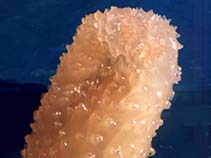Ascidia paratropa (Huntsman, 1912)
Glassy tunicate| Native range | All suitable habitat | Point map | Year 2050 |

|
| This map was computer-generated and has not yet been reviewed. |
| Ascidia paratropa AquaMaps Data sources: GBIF OBIS |
Classification / Names Common names | Synonyms | CoL | ITIS | WoRMS
Ascidiacea | Phlebobranchia | Ascidiidae
Environment: milieu / climate zone / depth range / distribution range Ecology
Sessile; depth range 0 - 100 m (Ref. 865). Temperate
Distribution Countries | FAO areas | Ecosystems | Occurrences | Introductions
Eastern Pacific: Alaska to Washington State.
Length at first maturity / Size / Weight / Age
Maturity: Lm ? range ? - ? cm Max length : 15.0 cm H male/unsexed; (Ref. 865)
Life cycle and mating behavior Maturity | Reproduction | Spawning | Eggs | Fecundity | Larvae
Main reference
References | Coordinator | Collaborators
Young, C.M. and E. Vazquez 1995 Morphology, larval development, and distribution of Bathypera feminalba n.sp. (ascidiacea: pyuridae), a deep-water ascidian from the fjords and sounds of British Columbia. Invertebrate Biology 114(1):89-106. (Ref. 1747)
IUCN Red List Status
(Ref. 130435: Version 2025-1)
CITES status (Ref. 108899)
CMS (Ref. 116361)
Threat to humans
Human uses
| FishSource |
Tools
More information
Diet composition
Food consumption
Predators
Max. ages / sizes
Length-weight rel.
Length-length rel.
Length-frequencies
Mass conversion
Abundance
Internet sources
BHL | BOLD Systems | CISTI | DiscoverLife | FAO(Publication : search) | Fishipedia | GenBank (genome, nucleotide) | GloBI | Gomexsi | Google Books | Google Scholar | Google | PubMed | Tree of Life | Wikipedia (Go, Search) | Zoological Record



